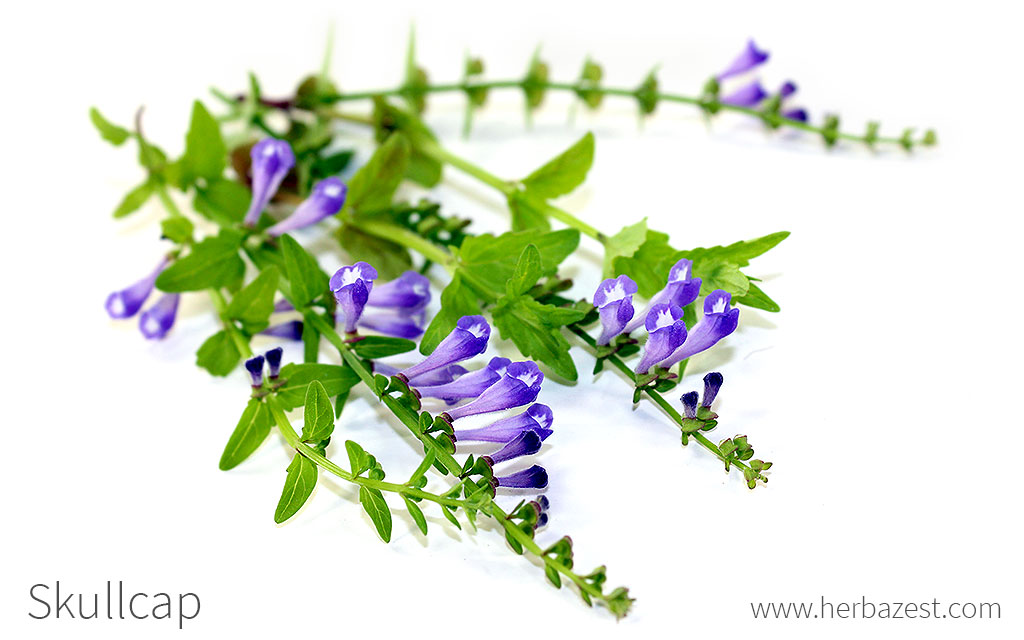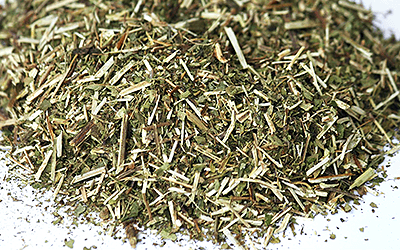Skullcap is native to Asia, Europe and North America, and it grows wild in most of the United States and Canada. The herb has a long history of use among Native Americans for a wide variety of medicinal purposes, and extensive research has validated many of its traditional applications. Nowadays, skullcap is mostly taken for its restorative properties and as a tonic to soothe the nerves.
Skullcap Medicinal Properties
- Medicinal action Antispasmodic, Sedative
- Key constituents Phenolic compounds, sesquiterpenes
- Ways to use Capsules, Hot infusions/tisanes, Tincture, Essential oil, Dried
- Medicinal rating (3) Reasonably useful plant
- Safety ranking Use with caution
Health Benefits of Skullcap
The antispasmodic, and sedative qualities of skullcap have made it a useful herb, full of pharmacological applications, mainly:
Treating anxiety and insomnia. The sedative qualities of skullcap have been used for centuries as a natural sleep-aid, to soothe the nervous system and relieve panic attacks.
Alleviating mild depression. A number of studies have shown the efficacy of skullcap for the treatment of mood disorders, alone or in combination with other herbs.
Because its antispasmodic properties, skullcap is used to relieve muscle spasms, as well as epilepsy and convulsions.
Scientific studies have suggested that skullcap may be useful for reducing withdrawal symptoms from addictive drugs.
How It Works
The pharmacological properties of American skullcap are yet to be fully understood, but over 12 phenolic compounds, including 10 flavonoids and two phenylethanoid glycosides have been isolated and are thought to be responsible for most of the herb's health benefits, mainly its antispasmodic, anticonvulsive actions.1
At least 73 compounds have been identified in skullcap's essential oil, and most of them are sesquiterpenes, mainly τ-cadinene, calamenene, β-elemene, α-cubebene, and α-humulene.2 These volatile oils are believed to be the cause for the sedative and anxiolytic effects of the herb. In double-blind human trials, individuals who took skullcap extracts significantly enhanced global mood, without a reduction in energy or cognition.3
TODAY, SKULLCAP IS MOSTLY TAKEN FOR ITS RESTORATIVE PROPERTIES AND AS A TONIC FOR THE NERVES.
Other herbs known for their sedative, relaxant properties are lemon balm, lavender, and St. John's Wort.
Skullcap Side Effects
Experts advise that American skullcap be obtained from a reliable source to avoid the possibility of contamination. High doses of skullcap are known to cause confusion, irregular heartbeat, and seizures.
Cautions
This herb should not be taken by pregnant or breastfeeding women. Chinese skullcap is not recommended for those who are taking medication for diabetes, as this particular variety can further reduce blood sugar levels.

How to Consume Skullcap
Natural Forms
Dried. The dried leaves of skullcap can be used to prepare a variety of home remedies.
Infusion. The dried leaves of skullcap can be steeped in hot water to make a soothing infusion.
Herbal Remedies & Supplements
Essential oil. Skullcap essential oil has a sedative action and provides a calming effect on the nervous system.
Tincture. In this concentrated form, skullcap is an effective sedative and anti-anxiety aid. Few drops diluted in a glass of water can relax the muscles, sooth the nerves, and induce sleep.
Capsules. Skullcap can be consumed in capsule or tablet forms, which come in standardized doses for treating seizures, mild depression, insomnia, and anxiety.

Growing
- Life cycle Perennial
- Harvested parts Leaves
- Light requirements Full sun
- Growing habitat Temperate climates
- Plant spacing average 0.3 m (0.98 ft)
- Propagation techniques Divisions
Skullcap is easy to cultivate. It can be grown from seed or by root division, and thrives in sunny, temperate climates.
Growing Guidelines
Skullcap needs plenty of moisture and grows better in well-drained soil.
It should be planted in early spring, after the last frost.
Skullcap plants need to be spaced about 6 - 12 inches (15 - 30 cm) apart.
It's important to strip away any weeds while skullcap is growing, and to trim the plant as it begins to flower.
Additional Information
Plant Biology
Skullcap is a leafy perennial herb that grows to around two feet (60 cm) in height. Skullcap is characterized by its bluish, violet, or pink flowers that are be cap-like in appearance.
Classification
Skullcap (Scutellaria lateriflora) is a member of the Lamiaceae or mint family, which comprises about 7,200 species of flowering plants, many of them important aromatic herbs, such as lemon balm (Melissa officinalis), sage (Salvia officinalis), rosemary (Rosmarinus officinalis), peppermint (Mentha x piperita), and basil (Ocimum basilicum).
Related Species of Skullcap
The Scutellaria genus contains 45 species. There are not known varieties or subspecies of S. lateriflora. However, it has several close relatives, including well-known species such as Baical skullcap (S. baicalensis) and marsh skullcap (S. galericulata),which can be found in North America, Asia, and Europe. Both of these species offer similar sedative and therapeutic properties to American skullcap.
Historical Information
The history of skullcap has deep roots in Native American culture as a healing herb for menstrual problems. The Cherokee people originally used skullcap to stimulate menstruation, relieve breast pain, and encourage expulsion of the placenta.
In the 19th century, skullcap was used by herbalists as a remedy for "hysteria," epilepsy, convulsions, rabies, and mental illnesses because of its sedative effects on the nervous system. Recently, skullcap has also been used in weaning patients from barbiturates and tranquilizers.
ACCORDING TO FOLKLORE, SKULLCAP WAS COMMONLY CALLED "MAD DOG" BECAUSE IT WAS WIDELY USED IN AMERICA DURING THE 19TH CENTURY TO TREAT RABIES.
Economic Data
According to the Saskatchewan Ministry of Agriculture, very little data has been published on skullcap production. In the U.S., yields of over 2,000 pounds per acre of dried American Skullcap have been reported. The selling price for skullcap was approximately $7 USD per pound in 2009. There has not been sufficient data published about other species of Scutellaria.
Other uses
Fodder. Besides its well-known medicinal uses, skullcap is popularly used to feed livestock.
Sources
- Government of Canada, Saskatchewan Ministry of Agriculture: Skullcap
- USDA Plants Database, Classification: Scutellaria L.
- Encyclopedia of Herbal Medicine, p. 135
- Medicinal Plants of the World, p. 295
- University of Maryland Medical Center, Skullcap
Footnotes
- Phytomedicine. (2009). Characterization of chemical ingredients and anticonvulsant activity of American skullcap (Scutellaria lateriflora). Retrieved June 24, 2024, from: https://pubmed.ncbi.nlm.nih.gov/18786819/
- Flavor and Fragance Journal. (1988). Volatile constituents of Scutellaria lateriflora L. Retrieved June 24, 2024, from: https://onlinelibrary.wiley.com/doi/abs/10.1002/ffj.2730030106
- Phytotherapy Research. (2014). American Skullcap (Scutellaria lateriflora): a randomised, double-blind placebo-controlled crossover study of its effects on mood in healthy volunteers. Retrieved June 24, 2024, from: https://pubmed.ncbi.nlm.nih.gov/23878109/






